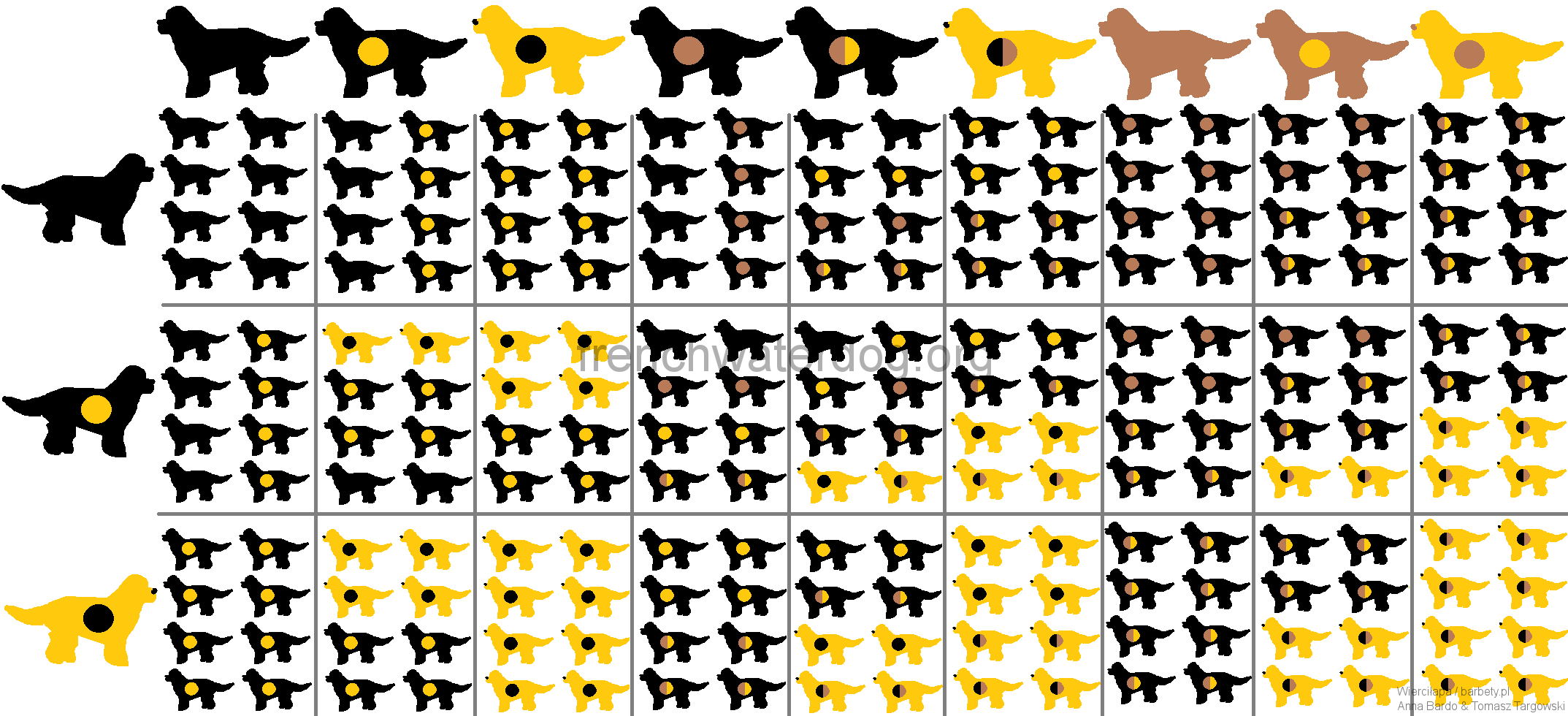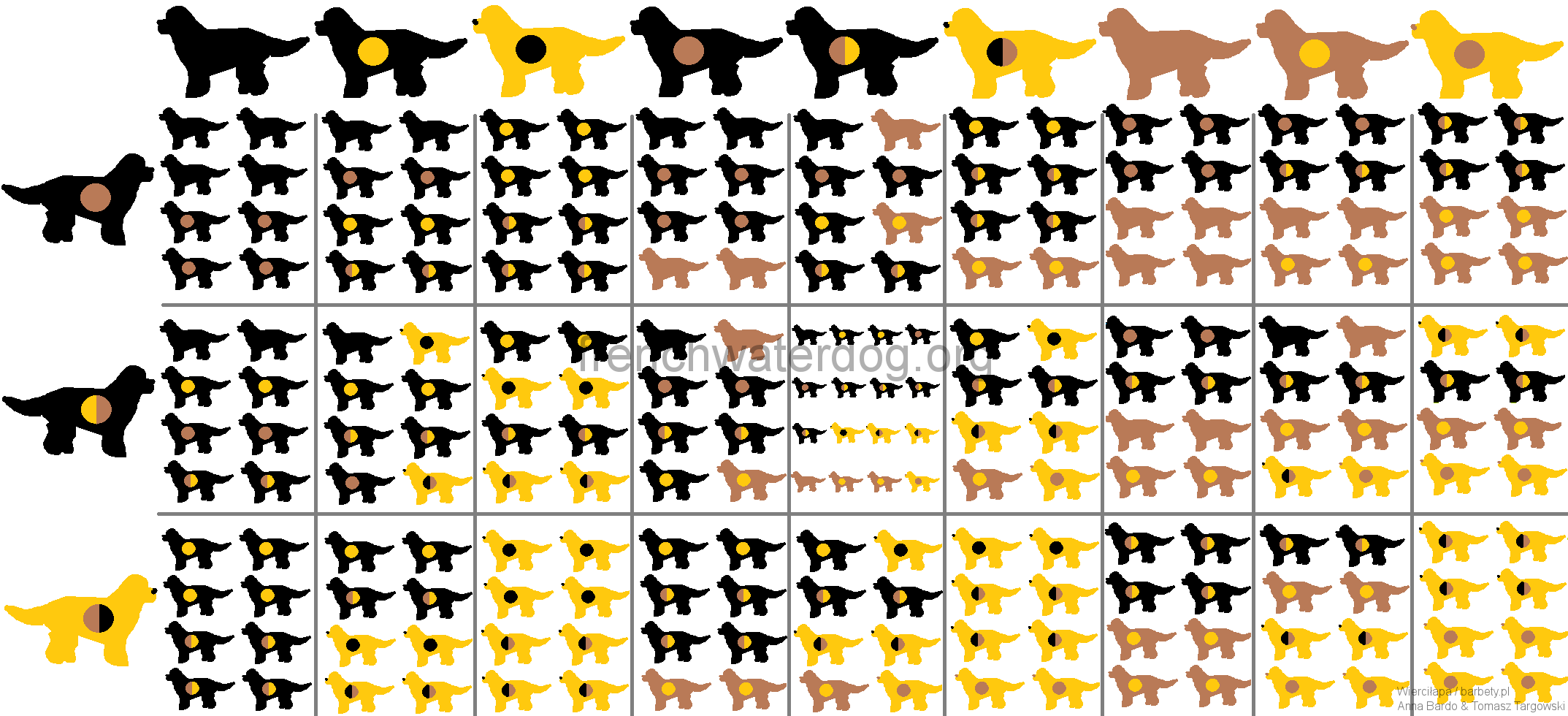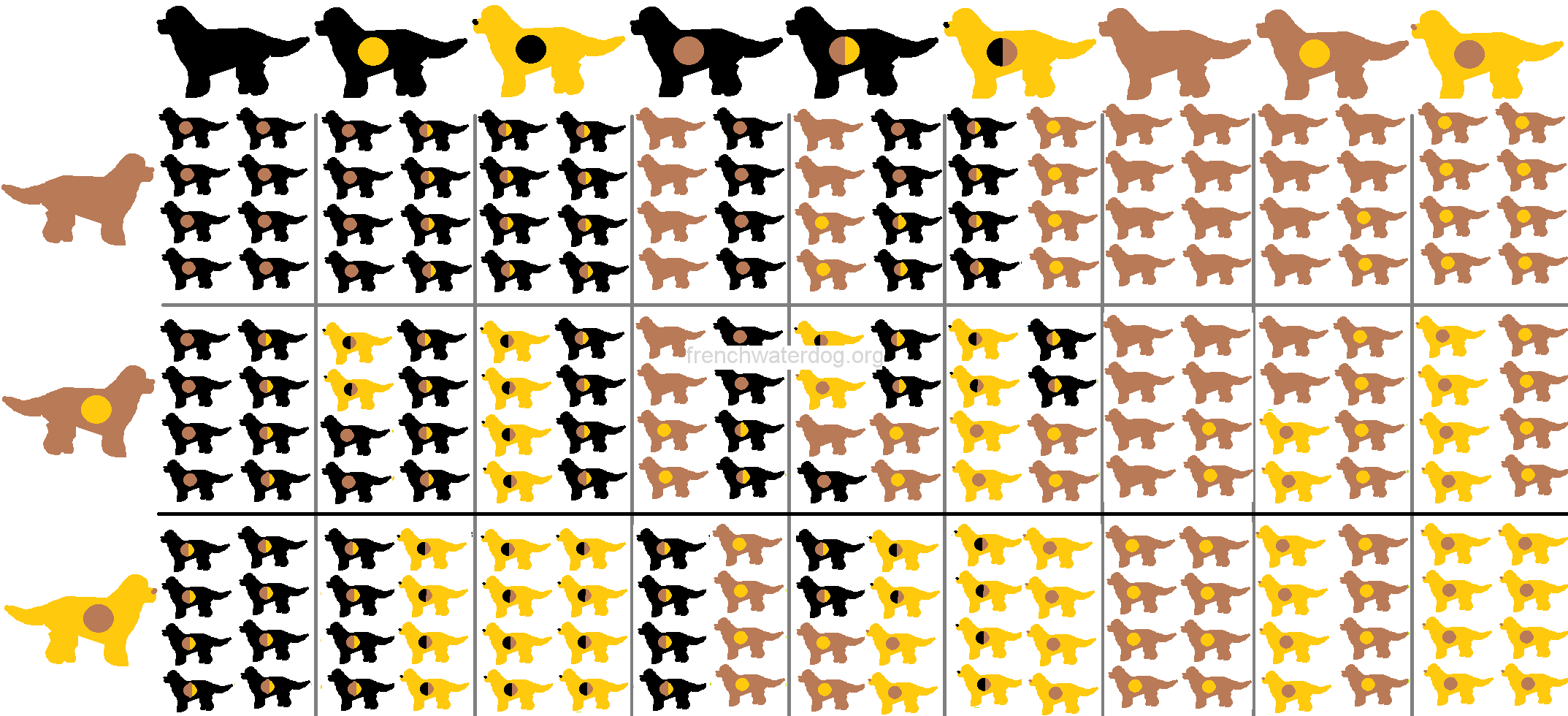Sole purpose of charts is to help predict the outcome of mating and also based on results of mating to determine the colors transfered by the parents. For example black female may as well carry only dominant black color – BB, or heterezygotus – Bb. Without making DNA test the only possible way to determine what she is carrying (BB or Bb) is to mate here with other brown dog or dog that carries brown (bb or Bb). If even one of the puppies is brown it means that the female is carrying Bb. This is just an example how the knowledge about coat colors may be used.
“Usually eliminating certain coat color is done without any logical reason. Wherever it is not biologically justified, all coats should be equally treated. Breeding dogs is hard enough without making it even more complicated by arbitrary setting allowed colors. If we breed only to color we are restrained to very small numbers of females and males. I strongly advise against breeding to color.” – quotes by Malcom B. Willis “Practical Genetics for Dog Breeders”
Every dog carries two alleles at each locus, only one of these alleles is general expressed (will influence the dog, while the other one will not…but still both are passed to progeny). Which of the alleles is expressed depends on dominance. The most dominant allele will always be the one which is expressed in the phenotype. A recessive allele is one which is less dominant.
Dominant alleles are generally written with a capital letter, for example B. Recessive alleles are written with a lower case letter, for example b. Sometimes there is more than one dominant or recessive allele on a locus. When this happens, there is usually an order of dominance, so one of the dominant alleles is more dominant than the other, and one of the recessive alleles is more recessive than the other.
Example: A dog with the BB genotype has two dominant alleles, and so it will only express B. A Bb dog will also express B because B is dominant over b. bb is the only genotype where the dog will express b. The same goes with EE (lack of sand mask), the only genotype where the sand mask will be expressed is ee. The sand will override the basic color wherever it is black or brown, black/brown pigmentation will be shown at the nose and eye rims of the dog
Genotype and phenotype. When it comes only to black/brown color and sand, there are nine possible combinations of genotype – BBEE,BbEE,bbEE,BBEe,BbEe,bbEe,BBee,Bbee and bbee. However from those genotypes only four phenotypes can occur – black dog, brown dog, sand dog with black nose and sand dog with brown nose. This is important to understand that two identical dogs (as of phenotype) may have different genotype. For example two black dogs may have BBEE and BbEe (both are black) each one of them mated with BbEe, will produce different puppies. First dog will produce only black progeny, while the second will give You a mix of colors – black, brown and sand.
There are many different locus that are responsible for dogs colors, although not all variations of alleles are presented in Barbets:
B locus – pigmentation color:
- B – black
- b – brown color
E Locus – Pigment Restriction/Extension, a very diverse set of alleles
- E – Full extension of pigment throughout the hair shaft
- e – Restriction of black and liver pigment in coat, normal intensity nose leather and eye rims. It results with sand color of the dog.
NOTE: There are rumors that mating two sand dogs can produce albino puppy. This of course this is false statement as albinism is caused by allele of C Locus.
G Locus – Greying factor
- G – greying with age which can start start very early, prevents creation of pigmentation (dog starts to loose pigmentation, which at first occurs in the least pigmented areas, the pigmentation lasts in the most pigmented areas – head, ears)
- gg – not greying (dog keeps the coat color)
NOTE: This locus has nothing to do with geriatric greying caused by aging. Dog with GG will turn grey faster then Gg, while dog with gg will keep the original color. Due to the dominance of G allele it is easy to avoid greying of projected puppies (avoiding even one greying parent). Greying (Gg or GG) parent will always pass the G allele to the progeny, resulting in half of the litter turning grey (parent Gg) or whole litter (parent GG).
S Locus – Various patterns of white spotting
- S – Solid color
- si- Irish spotting pattern
- sp- Piebald spotting pattern (Non symmetrical random white areas)
- s^w – Extreme white spotting pattern. Color headed white may be caused by modifying genes acting on this extreme white gene.
NOTE: Some of these alleles at the S locus may have incomplete or co-dominance. A dog that (si sp) may show both patterns simultaneously, for example. Due to this fact it is hard to judge which alleles the dog carries. Both of the alleles on locus can be expressed. This is called incomplete dominance, and only happens on particular locii. The resulting dog will have a mixture of the two alleles, but its markings will generally lean more towards the more dominant allele. S locus controls white markings, and the alleles in it display incomplete dominance over one another. sp is the allele for piebald (white markings covering 50% or more of the body), and S is the allele for no white markings. A spsp dog will be piebald, but even though S is slightly more dominant than sp, an Ssp dog won’t necessarily just be solid-coloured (as you would expect if a dog can only express its more dominant allele). Instead it may have some minimal white markings, because it is able to partly express it’s more recessive allele (piebald).
Charts below show You the statistical chance of passing alleles, the bigger the litter is the more accurate the result will be compared to statistics. If in chart all dogs from combination are marked with a same color (or carry same color/colors – circle inside) that means that unless there is a mutation – all the dogs from that combination (no matter if there is one or twelve puppies) will have the same genotype.
I. Black, brown and sand
Three charts below were made to present the inheritance of locus B (B-black,b-brown) and E (E-no mask, e-yellow/sand mask).



The circle inside the dog shows what colors he is carrying, but they aren’t expressed. Sand dogs have black noses when they carry B alles, if they do not, the nose is brown (b). Further we will discuss other locus that can influence Barbets coat: G-greying, S -white mark, and D-dillute.